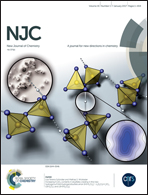Biosurfactant functionalized single-walled carbon nanotubes to promote laccase bioelectrocatalysis†
Abstract
Fast oxygen (O2) reduction at high positive potential is essential to obtain effective green energy conversion systems. Here, in an attempt to develop a desirable O2 reduction biocathode for fuel cells using laccase (Lac), we modify the surface of single-walled carbon nanotubes (SWCNTs) with various biosurfactants to obtain fast direct electron transfer from the SWCNTs to Lac, resulting in O2 reduction starting from a potential close to the redox equilibrium potential of the oxygen/water couple. We found that pyranoside- and sugar-type surfactants behaved as effective modifier layers of SWCNTs to facilitate Lac bioelectrocatalysis. In particular, SWCNTs modified with the pyranoside-type surfactant n-octyl-β-D-glucopyranoside and the sugar-type surfactant n-decanoyl-N-methyl-D-glucamine exhibited electron transfer rates between the type-1 Cu site of Lac and the modified electrodes of 4000 and 2500 s−1, respectively. The number of modifier layers adsorbed onto SWCNTs strongly influenced its effect on Lac bioelectrocatalysis.


 Please wait while we load your content...
Please wait while we load your content...